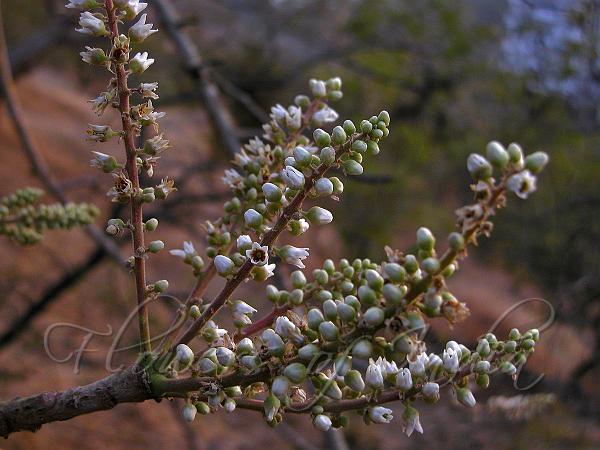|
| Indian Olibanum |
|

|

| File size | 465213 |
| Original date | 1/11/08 5:45 PM |
| Resolution | 1200 x 900 |
| Flash | Flash did not fire, auto |
| Focal length | 14.7mm |
| Exposure time | 1/250s |
| Aperture | 3.1 |
| Focus Distance | |
| Metering Mode | Spot |
| Camera make | NIKON |
| Camera model | E5700 |
| Sensor type |
|
|
|
|
Photo: |
Botanical name: Boswellia serrata Family: Burseraceae (Torchwood family)
Synonyms: Boswellia glabra, Boswellia thurifera, Bursera thurifera
Synonyms: Boswellia glabra, Boswellia thurifera, Bursera thurifera
Indian Olibanum is a deciduous tree endemic to India and has been recorded
on dry hills and slopes, on gravelly soils between an altitude range of
275-900 m. It is a medium sized tree, 3-5 m tall, but can grow up to
20 m tall, with ash coloured papery
bark. Alternately arranged leaves are pinnate, crowded at the end of
branches, 20-40 cm long. There are 8-15 pairs of leaflets, 3-6 cm long,
with an odd one at the tip. Leaflets are ovate, with toothed margin.
Flowers are tiny, creamy, about 8 mm across, borne in 10-15 cm long
racemes in leaf axils. There are 10 stamens with a short style and a
3-lobed stigma. Fruits are 2 cm long, 3-cornered. Indian Olibanum tree, on
injury, exudates an oleo-gum-resin known as Salai, Guggal or Indian
Frankincense. Flowering: January.
Medicinal uses: Extracts of Indian Olibanum have been
clinically studied for osteoarthritis and joint function, particularly for
osteoarthritis of the knee. A Boswellia extract marketed under the name
Wokvel has undergone human efficacy, comparative, pharmacokinetic studies.
Indian Olibanum is used in the manufacture of the supposed anti-wrinkle
agent "Boswelox", which has been criticised as being ineffective.
Extracts of Indian Olibanum have been
clinically studied for osteoarthritis and joint function, particularly for
osteoarthritis of the knee. A Boswellia extract marketed under the name
Wokvel has undergone human efficacy, comparative, pharmacokinetic studies.
Indian Olibanum is used in the manufacture of the supposed anti-wrinkle
agent "Boswelox", which has been criticised as being ineffective.
Medicinal uses:
 Extracts of Indian Olibanum have been
clinically studied for osteoarthritis and joint function, particularly for
osteoarthritis of the knee. A Boswellia extract marketed under the name
Wokvel has undergone human efficacy, comparative, pharmacokinetic studies.
Indian Olibanum is used in the manufacture of the supposed anti-wrinkle
agent "Boswelox", which has been criticised as being ineffective.
Extracts of Indian Olibanum have been
clinically studied for osteoarthritis and joint function, particularly for
osteoarthritis of the knee. A Boswellia extract marketed under the name
Wokvel has undergone human efficacy, comparative, pharmacokinetic studies.
Indian Olibanum is used in the manufacture of the supposed anti-wrinkle
agent "Boswelox", which has been criticised as being ineffective. | Identification credit: Satish Phadke | Photographed in Maharashtra. |
• Is this flower misidentified? If yes,